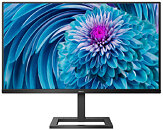Thursday, January 21st 2021

Philips Releases 288E2UAE Monitor: 28" 8-bit IPS, 4K, 60 Hz, 4 ms, 119% sRGB - $300
Philips today via its distributor MMD announced the 288E2UAE Monitor, a cost-effective 4K monitor with a 28" diagonal. The monitor features a native 8-bit display (10-bit FRC) with a pretty run-of-the mill 60 Hz refresh rate, 300 cd/m² luminance and 1000:1 static contrast for its 4K resolution. The 4 ms response time won't earn it any accolades, but that's to be expected on a 4K resolution monitor that is expected to retail for around $300. The 119% sRGB and 106.9% NTSC coverage sit above the mainstream monitors for color reproduction, but likely won't be enough for content creators - despite the monitor's color accuracy of DeltaE < 2.
I/O wise, the Philips 288E2UAE offers a 5x USB 3.2 hub, configured at 1x upstream and 4x downstream ports, 1x HDMI and 1x DisplayPort, alongisde 1x 3.5 mm audio output and 2x 3 W integrated speakers. The display further features an anti-reflection coating, and firmware-based EasyRead, Flicker-free and LowBlue technologies.
I/O wise, the Philips 288E2UAE offers a 5x USB 3.2 hub, configured at 1x upstream and 4x downstream ports, 1x HDMI and 1x DisplayPort, alongisde 1x 3.5 mm audio output and 2x 3 W integrated speakers. The display further features an anti-reflection coating, and firmware-based EasyRead, Flicker-free and LowBlue technologies.



75 Comments on Philips Releases 288E2UAE Monitor: 28" 8-bit IPS, 4K, 60 Hz, 4 ms, 119% sRGB - $300
And seeing how Eizo's professional screen, the HP DreamColor max out at 60Hz, it doesn't seem like the pro market is asking for high refresh rate.
It's odd how high refresh screen on smartphone is a wanted feature even outside of the gaming benefits, but once again, pc's screens are lagging behind.
Display tech itself is not an issue, controllers and bandwidth are.
Even current implementations of 4K at higher than 100Hz require various workarounds (compression+chroma subsampling, or using two ports to facilitate bandwidth, etc.etc.etc.).
Gotta wait at least 'till 2022-2023 to see something real and adequately-priced (especially due to DP2.0 delays).
A lot of the games I play can do more than 60Hz, but rarely over 100Hz, although I guess by now, I have a fairly modest graphics card :(
In luck, Asus has already announced a 120hz+ version of the Tuf 28" 60hz monitor for later this year. Of course it might cost more than double, expect $300 --> $600 minimum.
I'm frankly surprised that anyone is still manufacturing 60Hz LCD panels outside of the very low end - and to be honest, I wouldn't be surprised if these panels were capable of more if tuned properly.
I'm not a big fan of frc, if not implemented good it can possibly cause banding in some scenarios, it also sucks that windows 10 isnt true 10-bit colour on the desk top, I feel like its 1998.
Also my LG 27UL550-W I picked up from best buy 1 year ago for $350 cnd
www.lg.com/us/monitors/lg-27UL550-W-4k-uhd-led-monitor
@W1zzard
This deserves a proper review by one of the staff. Just an idea.
I'm sure generalized statements do more harm than good and that is literally what you have said which is also what I'm also saying. There are no cheap and easy solution in display hardware like gamut beats all other variables.
PS: I'm defending the announced display, not discrediting it on a vague reference.
although it is not as dark in the sun. I think the light bleed really won't let it, afterall it is sdr calibrated display not quite like actual oled.Today you only see TN in gaming segment.Theoretically - yes, practically - no. Low demand on these things doesn't drive semiconductor manufacturers to deliver powerful-enough SoCs to handle 120Hz. So, in order to do so, a monitor manufacturer still needs "messing around" with custom solutions, like having two scalers on one board which will drive half the screen each or alternate frames, or rolling-out an even more expensive FPGA-based solution. DP2.0 was announced too soon, so no one really bothered to develop new ICs for soon-to-be-outdated standard, so they most likely kept their focus on DP2.0.OLED monitors are on their way. Just gotta wait a year or two for something decently-priced to arrive. I believe Samsung has already some things cooked up for this year, but it's gonna be expensive.
There are some good IPS alternatives with crazy pixel densities, but realistically IPS will never be as good as OLED.
Also, your initial wording is problematic. Slow red decay literally means that the red phosphors in the nanoparticle layer have a slow light decay, i.e. they keep giving off light a bit longer than they ought to. "Red shift" like you termed it sounds like colors are generally shifted towards red, essentially implying a noticeable tint to the panel (and thus terrible color accuracy). This is clearly not the case. Using precise wording matters.
The main thing is still the overall quality, not some fringe benchmark. You might leave it at that. I'm really going to make a class example of it and I have the credits.
I understand you want to argue on the premise of monitors in general; however that is not the case. IPS and VA, each have their differing strong suits and it doesn't help anyone to blur the lines between them. If I cannot argue what makes a display good why would I argue? You should let me make the points clearer imo.
I'm sick and tired of all these IC vendors that do half assed implementations of standards in their chips, as time and time again this means that we end up with several revisions of crap that doesn't work as claimed. Can we go back to a time when quality stood for something and products were tested properly before being pushed into the market?